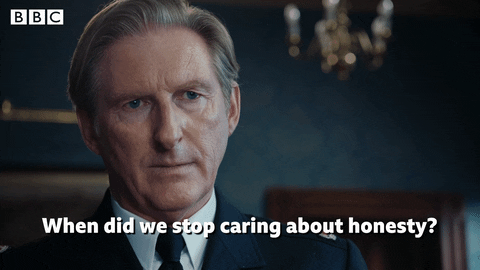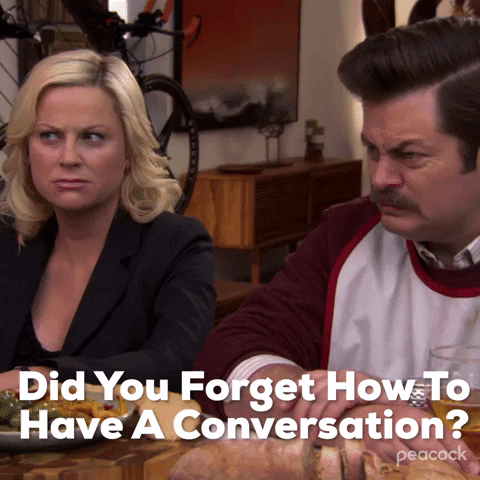
I’ve had my fair share of incomplete conversations in the hallway. You know, those conversations that are like, “Hey, can you come by my office later today? I need to talk to you.” That conversation leaves me with my anxiety striking at 300% and a 500 heartbeat per minute. This is one of the most common mistakes of professional communication within the workplace. You didn’t tell me why, or what is it?! Give me something brief about what we’re going to talk about, y’know? I’ve been on both ends, being an employee and an employer. I’ve learned that communication skills need to be educated on all levels within the work-with-me realm.

Q: What do you do to make your point clear and candid during the conversation?
A: The best conversations to have where everyone will learn and engage with each other are conversations that are entirely based on candor and honesty (Welch, 2005). These conversations are difficult to have because they incorporate raw truths that allow vulnerability, pain, embarrassment, and shame. Acknowledging the issue early on within conversation interactions will enable trust to be built. There would be fewer chances of having one side of the conversation be shocked or embarrassed (Welch, 2005). Allow all emotions to subside from the conversation as a topic may be interpreted in a negative connotation. State facts more than opinions within a conversation; list down what you have observed and SMART goals that could be listed as solutions towards any topic of discussion. SMART goals are specific, measurable, achievable, reachable, and time-efficient. These goals and other assistance methods will allow the other individual to show that you care about their success within the workplace and that you want to work with them to develop solutions and enhance their performance.

Q: How do you remove your emotion from the conversation while maintaining empathy and trust with another coworker/employee?
A: The only way to remove your emotion from the conversation while still maintaining empathy and trust with another is to be vulnerable with sharing your experience (8 Ways to Build Workplace Relationships, 2020). There is a fine line between over-sharing and talking aimlessly and giving a lesson by relating to another an experience where they could engage with you and learn from you. Do not over-personalize and portray yourself excessively within the knowledge that you are delivering. Explicitly send the message directly while adding your input and experience within it: give the individual near-tangible expertise, something that they could hold onto and remember (8 Ways to Build Workplace Relationships, 2020).

Q: What techniques do you employ to build effective working relationships, and why would you choose these techniques?
A: I have three techniques that I stick by: collaborate, keep a growth mindset, and practice active listening (Welch, 2005). Continuous collaboration with other team members provokes conversations to open up, so I don’t worry about taking the initiative to talk first. I’d instead show that I am working alongside the team, and my work and effort will do the talking for myself. By keeping a growth mindset, not only do I practice open-mindedness, but I also practice respect towards my boundaries and others as well (James & Warren, 2009). Plus, I continuously learn from my experiences (good or bad). Active listening is very crucial to all work environments; it’s a skill that amplifies the need for communication and gets things done more efficiently and effectively. It also shows other individuals that you care about them and want to work the best alongside them. These three techniques work best because they correlate well and have provided me with the best results in my work-study-life balance.
References
8 Ways to Build Workplace Relationships. (2020, January 3). Retrieved from Indeed: https://www.indeed.com/career-advice/career-development/how-to-build-relationships
James, O., & Warren, B. (2009, June). A Culture of Candor. Retrieved from Harvard Business Review: https://hbr.org/2009/06/a-culture-of-candor
Welch, J. (2005). Winning. New York: HarperBusiness Publishers.

Here’s a brief sample dialogue recording the conversation between myself and a coworker that demonstrates the use of the strategies outlined above.
Me: Good morning, Fatimah! How are you? I hope that you and your family are well.
Fatimah: Good morning, Susan! Yes, my family and I are well, thank you for asking.
Me: I’m so glad to hear that you are well. I want to schedule an appointment with you this afternoon, right after work, if you are available. I’m looking at 3 pm or 3:30 pm today, preferably at [this coffee shop location].
Fatimah: I will be available at 3 pm.
Me: All right, sounds good. I’ll see you then!
- 3 PM at [this coffee shop location]
Me: Welcome, Fatimah! Thank you so much for coming in on time; I appreciate that.
Fatimah: No problem, I’m glad I made it on time.
Me: Fatimah, you are a tremendous asset to our company, and I have been seeing some beautiful results coming out of your experience with us. However, lately, I have been noticing an inevitable drop in your performance.
Fatimah: Yes, I know.
Me: I would like to help you. Allow me to demonstrate something to you. [Pull out stats and performances records for projects A, B, C, D, and F]. If you look at your performance for tasks A, B, and D, you have excelled in completing those projects independently and in some group sectors. However, you’ve struggled immensely for projects C and F and did not complete them on time.
Fatimah: Yes, projects C and F have been extremely difficult because they concentrate on [this and this skill]. I lack experience in these skills and find it very difficult to work on them independently.
Me: I understand that some skills don’t come to us as fast as others. Would you please reach out to me whenever you struggle with the completion of a project? We have workshops and training programs available for employees who would like to enhance their skillset in [this and this skill]. Additionally, I could facilitate a couple more projects to get you back on track until you can practice working on [this and this skill] during your training program.
Fatimah: Thank you so much; I didn’t know that these resources were available and that I can comfortably explain my situation to you.
Me: No problem, Fatimah. My job does not only focus on the success of the company but also make sure that every individual can achieve success. Development is a path of learning, and everyone is on that path. If you ever need any support or find difficulty with anything, please let me know, and I will guide you to the best of my abilities.
Fatimah: Sounds good. Thank you, Susan.
Me: Thank you for your time, Fatimah. Let’s meet again in another two weeks; by then, you should’ve completed [this percentage] of your development program and completed a project or two within that time frame. Additionally, note down anything that you have found to have assisted you or found interesting so we can talk about it next time.


